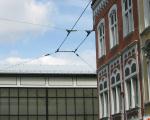 ende_wup1.jpg (94116 bytes)
ende_wup1.jpg (94116 bytes)|
The Railfaneurope.net Picture Gallery
Directory: /pix/de/trolleybus/Solingen/misc
Last update: Tue Mar 23 18:26:41 CET 2010
|
|
The end of the trolleybus catenary at the end station Wuppertal-Vohwinkel
Schwebebahn seen on 13 September 2003. Due to construction works at the
Schwebebahn (the famous suspended railway of Wuppertal), the catenary is
removed at the corner Vohwinkeler Straße/Rubensstraße, so the bus
line 683 (running to Solingen Burg where there is a turntable for busses) is
operated by diesel. The building in the background is the end station of the
Schwebebahn.
Digital photo by Christoph Schmitz |
|
The catenary configuration at the corner Gräfrather
Straße/Rubensstraße seen on 13 September 2003. Busses of line 683
coming down the Gräfrather Straße turn left into the
Rubensstraße here. Then they run via Vohwinkeler Straße and come up
the Gräfrather Straße again. So the catenary crosses itself here.
Digital photo by Christoph Schmitz |
|
The catenaries near the station Zentral seen on 13 September 2003. On the left
line 682 runs to Ohligs Bf, in the background line 683 leads to
Wuppertal-Vohwinkel. Coming from the center of Solingen (from the right), there
is a switch forking the catenaries far before this point. The switch where the
catenaries coming from Ohligs and Vohwinkel join is visible in the foreground.
Digital photo by Christoph Schmitz |
|
The catenaries near the station Zentral seen on 13 September 2003. This is a
close-up onto the crossing where the catenary to Ohligs (from right to left)
crosses the catenary coming from Vohwinkel (from the background).
Digital photo by Christoph Schmitz |
|
The catenaries leaving the station Schlagbaum northbound, seen on 13 September
2003. The left catenary leads into the Kronprinzenstraße (line 681 to
Ohligs Bf and line 686 to Aufderhöhe), the one in the middle into the
Schlagbaumstraße (line 682 to Ohligs Bf and line 683 to
Wuppertal-Vohwinkel Schwebebahn) and the right one into the Kuller Straße
(line 684 and 685 to Hasselstraße). The last two fork at a switch behind
the station, visible in front of the tree in the upper right corner. The left
one forks before the station, and the busses use different platforms at
Schlagbaum.
Digital photo by Christoph Schmitz |
|
An electric separation of the catenary, seen near the station Zentral on 13
September 2003. Note the wires coming from the right, it seems that the
catenary is feeded with electricity at this point.
Digital photo by Christoph Schmitz |
|
Solingen trolleybus line 683 at the terminus in Wupertal Vohwinkel,
on a bitterly cold 7-1-97. The other terminus is the famous turntable.
Photo and scan by R. Helder (ronald.helder@wxs.nl) |
|
A catenary switch at Ohligs Bf, seen on 13 September 2003. There are two
tongues at each side, one for each direction. The are operated by the drives
located above. This is only the tongue section of the switch, the frog section
(with a third drive) is shown on a picture which should be below this one.
Digital photo by Christoph Schmitz |
|
A catenary switch at Ohligs Bf, seen on 13 September 2003. This is what is
called the frog on normal (railway) switches. The drive located above moves
four tongues which form the "rail" for the pantograph. As the pantographs move
indipendently, it is not possible to let the other one running on the outer
"rail" (visible near the edge) guide the one passing the frog (as it is done
with the wheels at railways).
Digital photo by Christoph Schmitz |
|
The catenary switch at the station Zentral seen on 13 September 2003. This is
where line 682 to Ohligs Bf runs to the left and line 683 to
Wuppertal-Vohwinkel Schwebebahn runs to the right. The switch is far before the
road crossing where the lines actually fork, this point can be in the lower
left corner (at the green house). So the driver has enough time to see if the
switch did the right thing and the pantographs are going to take the same way
as the bus. If not, he still can stop and set them to the other catenary
manually. There is also a signal showing the position of the switch, it is
visible next to the house behind the yellow traffic sign and in the enlargement
in the upper left corner.
Digital photo by Christoph Schmitz |